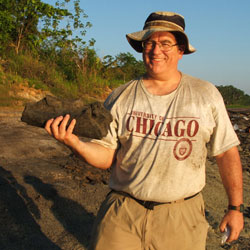![]()
 John
J. Flynn
John
J. Flynn
Division of Paleontology
American Museum of Natural History
Central Park West at 79th St.
New York, New York
USA
John Flynn is the Frick Curator of Fossil Mammals & Dean, Richard Gilder Graduate School at the American Museum of Natural History. Author of more than 100 scientific publications, Flynn's research focuses on the evolution of mammals and Mesozoic vertebrates, geological dating, plate tectonics, and biogeography. He also is curator for the Museum’s recently opened “Extreme Mammals” exhibit, and has contributed articles to Scientific American, Natural History, and National Geographic, provided scientific expertise for several popular science books, and been featured in numerous television and radio shows, newspapers and magazines. Dr. Flynn has led more than almost 50 paleontological expeditions to Chile, Perú, Colombia, Madagascar, Angola, India, and the Rocky Mountains, supported by the U.S. National Science Foundation, the National Geographic Society, NASA, and other organizations. In 2001 Flynn received a Guggenheim Fellowship for a year of research, writing and expeditions in South America. He has served as a member of the External Advisory Board for Yale's Peabody Museum, and elected President (1999-2001) and member of the Board/Executive Committee (1993-2002), as well as recipient of the Joseph T. Gregory Award (2007) and the Alfred Sherwood Romer Prize, of the Society of Vertebrate Paleontology. With a specialty in mammalian paleontology and paleomagnetism, Flynn has spent his career searching for important new fossil mammal localities, as well as developing better ways to read the age of rocks and fossils, leading to more accurate geological time scales. He has contributed to numerous public education projects (university, museum, web, and popular science), is actively pursuing research on mammalian evolution (particularly the anatomy, DNA and evolution of Carnivora and extinct relatives), and has current field programs focusing on the Andes Mountains of Chile, Amazon Basin of Perú, and Mesozoic deposits of Madagascar and India.